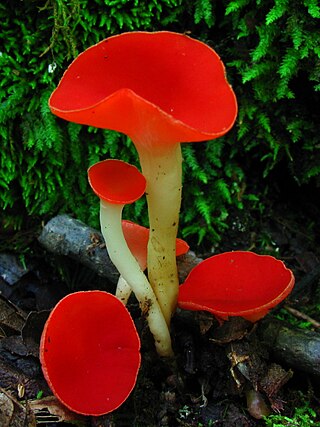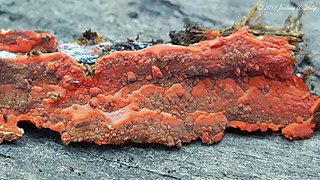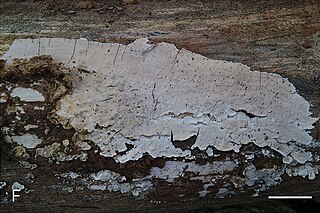
Mycology is the branch of biology concerned with the study of fungi, including their taxonomy, genetics, biochemical properties, and use by humans. Fungi can be a source of tinder, food, traditional medicine, as well as entheogens, poison, and infection. Mycology branches into the field of phytopathology, the study of plant diseases. The two disciplines are closely related, because the vast majority of plant pathogens are fungi. A biologist specializing in mycology is called a mycologist.

Polyporus is a genus of poroid fungi in the family Polyporaceae.

The Polyporaceae are a family of poroid fungi belonging to the Basidiomycota. The flesh of their fruit bodies varies from soft to very tough. Most members of this family have their hymenium in vertical pores on the underside of the caps, but some of them have gills or gill-like structures. Many species are brackets, but others have a definite stipe – for example, Polyporus badius.

Lewis David de Schweinitz was a German-American botanist and mycologist from Bethlehem, Pennsylvania. Considered the "Father of North American Mycology," he also made significant contributions to botany.

Peniophora albobadia is a species of crust fungus in the family Peniophoraceae.
Rhytisma vitis is a species of fungus in the family Rhytismataceae. It was described by Lewis David de Schweinitz in 1832.

Globifomes is a fungal genus in the family Polyporaceae. It is a monotypic genus, containing the single North American species Globifomes graveolens, commonly known as sweet knot. This fungus is found fruiting singly or in groups on trunks or logs of hardwood trees, primarily oaks. The fruit body consists of a mass of small overlapping hoof-shaped caps arising from a common core. It is initially dull yellow-brown with tan petal-shaped margins, aging to dark brown.

Cantharellus lateritius, commonly known as the smooth chanterelle, is a species of edible fungus in the mushroom family Cantharellaceae. The species has a complex taxonomic history, and has undergone several name changes since its first description by American mycologist Lewis David de Schweinitz in 1822. The fruit bodies of the fungus are brightly colored yellow to orange, and usually highly conspicuous against the soil in which they are found. At maturity, the mushroom resembles a filled funnel with the spore-bearing surface along the sloping outer sides. The texture of the fertile undersurface (hymenium) of the caps is a distinguishing characteristic of the species: unlike the well-known golden chanterelle, the hymenium of C. lateritius is much smoother.

Sarcoscypha occidentalis, commonly known as the stalked scarlet cup or the western scarlet cup, is a species of fungus in the family Sarcoscyphaceae of the Pezizales order. Phylogenetic analysis has shown that it is most closely related to other Sarcoscypha species that contain large oil droplets in their spores. S. occidentalis has an imperfect form, classified as Molliardiomyces occidentalis.

Galiella rufa, commonly known as the rubber cup, the rufous rubber cup, or the hairy rubber cup, is a species of fungus in the family Sarcosomataceae. It produces cup-shaped fruit bodies with the texture of tough, gelatinous rubber, with a rough, blackish-brown, felt-like outer surface and a smooth reddish-brown inner surface.

Boletinellus merulioides, commonly known as the ash-tree bolete, is a species of bolete fungus in the family Boletinellaceae. Described as new to science in 1832, it is found in Asia and eastern North America, where it grows on the ground near ash trees.

Picipes badius, commonly known as the black-footed polypore or black-leg, is a species of fungus in the family Polyporaceae. It causes a white rot of hardwoods and conifers. The species is found in temperate areas of Asia, Australia, Europe, and North America. It has a dark brown or reddish-brown cap that reaches a diameter of 25 cm (9.8 in), and a stipe that is often completely black or brown at the top and black at the base.

Lentinus strigosus is a species of fungus in the family Polyporaceae. It is edible when young, but becomes very tough with age.

Phlebia incarnata is a species of polypore fungus in the family Meruliaceae. It is inedible.

Multiclavula vernalis or the orange club-mushroom lichen is a species of clavarioid fungus in the Clavulinaceae family. It was originally named as a species of Clavaria in 1822 by Lewis David de Schweinitz. Ronald H. Petersen transferred it to Multiclavula in 1967.

Polyporus leprieurii is a species of poroid fungus in the genus Polyporus. It was first described scientifically by French mycologist Camille Montagne.

Phlebia coccineofulva, commonly known as the scarlet waxcrust, is a species of crust fungus in the family Meruliaceae. It was described as a new species by Lewis David de Schweinitz in 1832. The fungus is found in North America, continental Europe, and northern Asia, where it grows as a saprophyte on decaying stumps and woody forest debris.

Sarcodontia crocea is a species of toothed crust fungus in the family Meruliaceae. The species was first described scientifically in 1822 by Lewis David de Schweinitz, who called it Sistotrema croceum. It was transferred to the genus Sarcodontia by Czech mycologist František Kotlaba in 1953. S. crocea usually occurs on old fruit trees, in which it causes a white rot. It is found in Europe, Asia, and North America. It is red-listed in several European countries.

Datroniella scutellata is a species of fungus in the family Polyporaceae, and the type species of genus Datroniella.

Lopharia cinerascens is a species of crust fungus in the family Polyporaceae. It was first described by botanist Lewis David de Schweinitz in 1832 as Thelephora cinerascens. Gordon Herriot Cunningham transferred it to Lopharia in 1956. It is widely distributed in Africa, Asia, Australasia, and North America; it is less common in Europe and South America.



















